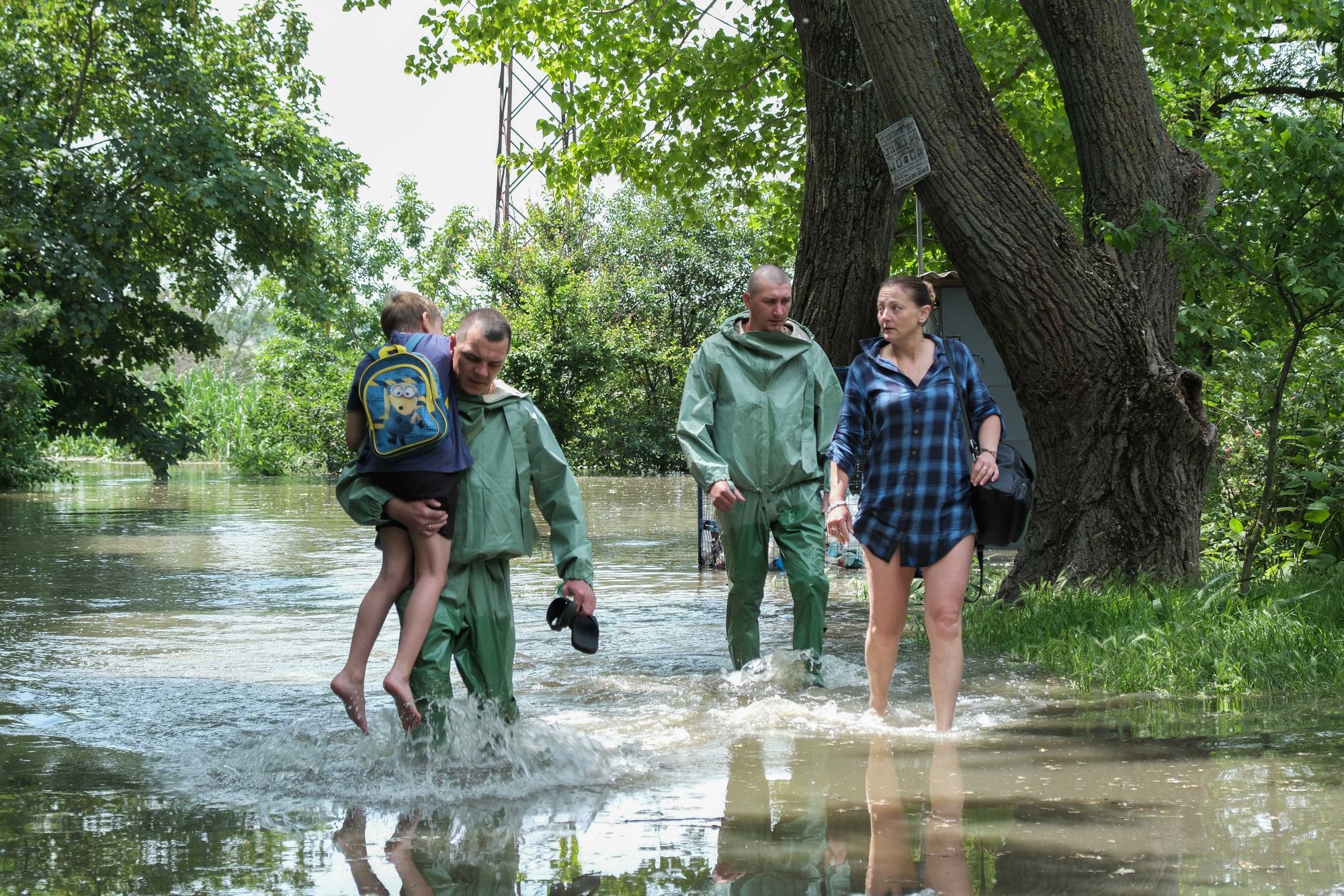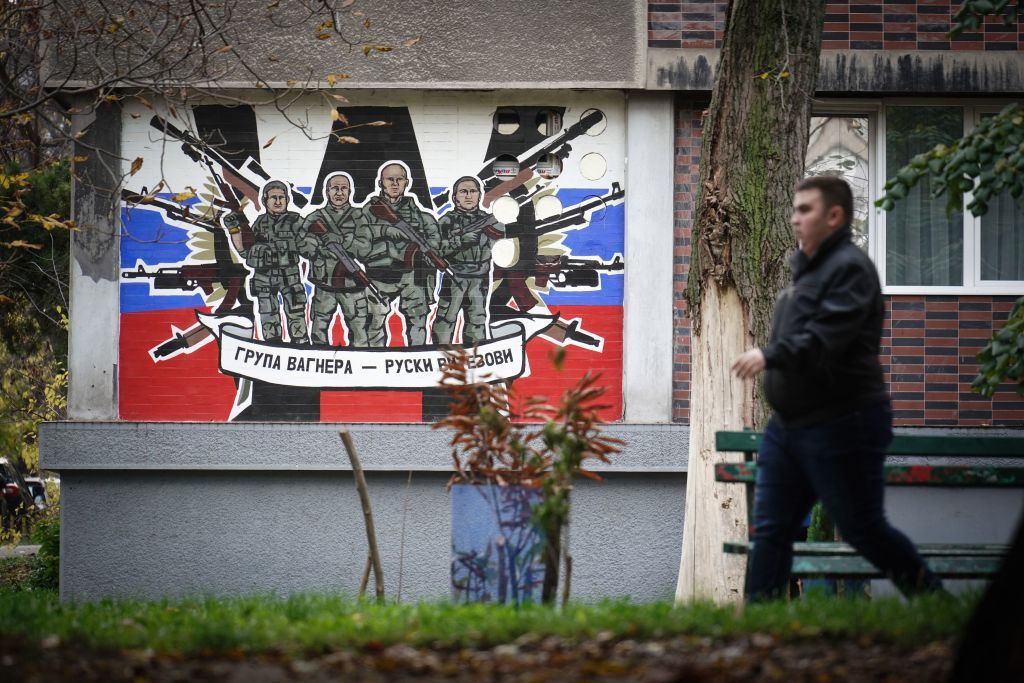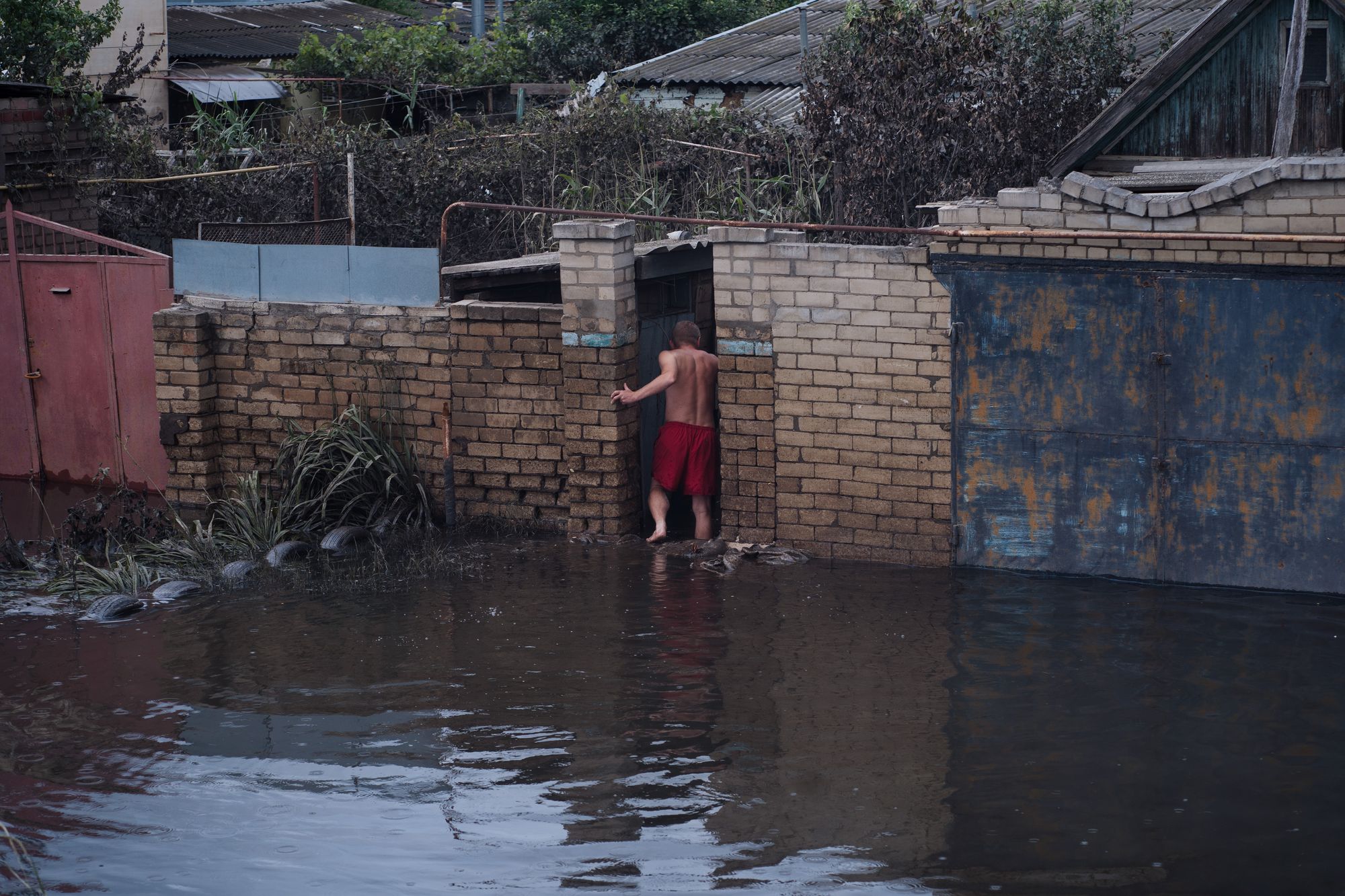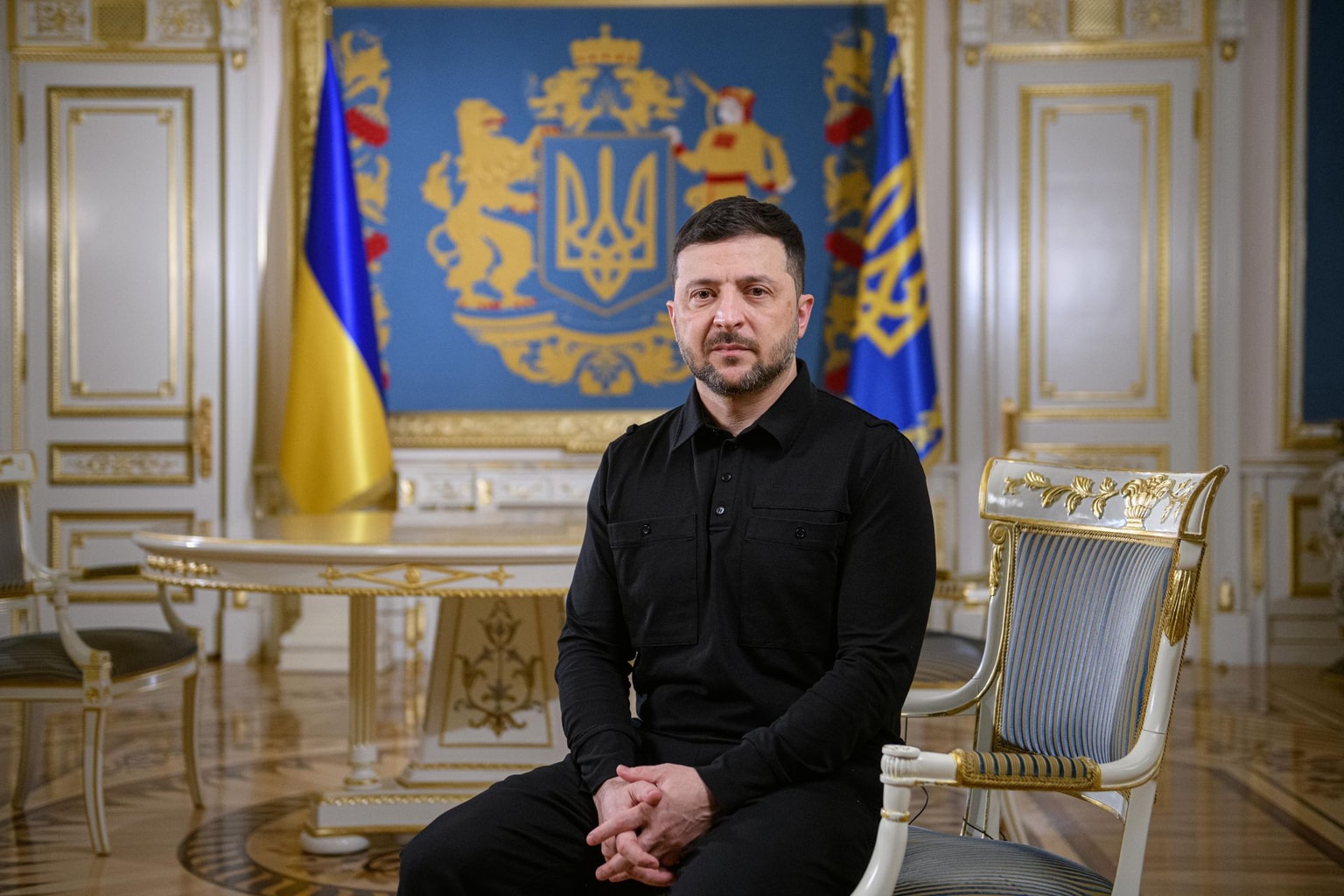How Russian soldiers shared evidence of their own war crime

Editor’s note: This story is the first account of the Kyiv Independent’s contributor, Anthony Bartaway, who witnessed Russian shelling targeting volunteers during relief efforts following the destruction of the Kakhovka dam and the ensuing devastating flooding in Kherson Oblast.
After Russian forces destroyed the Kakhovka dam on the night of June 6, volunteers from all over the country and the world rushed to the flooded Kherson Oblast to save whoever and whatever they could. But the typical dangers of flooding were compounded by a constant drum beat of Russian artillery from just on the other side of the water, targeting rescuers and victims of the disaster as they were trying to receive much needed aid.
One such group was a team of German volunteers called 4Paws Rescue, which focused on saving animals. They went to Kherson to help those affected by the manufactured flood but ended up facing the dangers of being on the front line of Russia’s invasion of Ukraine.
Their team, along with others at the same evacuation point, came under fire from Russian artillery. Myself among them. One volunteer was severely wounded.
Russian forces had been shelling Kherson since the city at the mouth of the Dnipro River was liberated from their occupation in November, but this incident proved somewhat unique.
The Russian artillery crew responsible filmed and publicized their attack, providing direct evidence of their war crime.
Ominous day
I met with 4Paws at a guest house in Kherson that had become a hub for press, volunteers, and soldiers.
Some of their members had been volunteering in Ukraine since the early days of the full-scale invasion and were involved in animal rescue efforts in many places, including Bucha and Kharkiv.
For this trip, they communicated with UAnimals, one of the country's largest animal welfare organizations. Their initial task in Kherson was to set up an animal shelter for UAnimals, but they ended up coming prepared and equipped to rescue animals directly from the flood.

The day of June 14 was a long one and might have been ominous.
The civilian relief efforts in Kherson were fairly chaotic and could be a complex web of permissions and coordinating who can get ahold of what equipment and when. After waiting several hours for a permit from the military authorities of the city to enter the flood waters, then came securing a metal boat from other volunteers that could handle the dangerous current of the swollen Dnipro River. By the time the actual work could begin, it was already late afternoon.
Sometime between five and six o'clock in the afternoon, the crew arrived near a boat launch in the southwest of Kherson, immediately to the west of the rail bridge across the Koshova River. In peacetime, the bridge was the primary freight connection to the dockyards and warehouses of the Korabelnyi neighborhood that drove much of the city’s economy. The Russian army is now perched on the opposite bank of the Dnipro, constantly shelling the area and making shipping impossible. With the Russian-made flood, Korabelnyi was swallowed by the deluge and was the focus of most of the rescue efforts within the city limits of Kherson.
4Paws had received information from sources working within the neighborhood about pets that had been left behind during evacuations and people waiting out the flood waters in the higher floors of multi-story apartments.
However, even at the gathering point roughly 500 meters from the boat launch, there had to be more waiting, and we got news of more serious trouble. Police at a block post on the scene warned that the Russians had set up a tank on the opposite side of the Dnipro that had targeted the area with indirect fire the day prior and that they had a clear shot down the length of the road leading to the river.
The team’s sense of worry was rising, and now we were running out of daylight. But, during the wait, we met with several other volunteers from other rescue groups: House of Hope and Kyiv Animal Rescue Group. They would soon prove to be invaluable.
While there was now much more trepidation than earlier in the day, the decision was made to proceed with the mission shortly before 7 p.m. The launch had only recently been covered by the then-receded floodwaters, so it was a big mud flat. After helping the team to disembark and get the engine working, some other members and I decided to vacate the area so the Russian drones would not see a large group of people to target.

After returning to the meeting point, we got word that the boat’s engine was stalling out and that we would need to retrieve the crew.
But then it came.
The telltale whistle of artillery shells ripped the air, followed by the explosions from their impact. Within the span of a few minutes, roughly five struck nearby.
Shortly thereafter, the House of Hope team sped back in the direction of the city, yelling to get to safety. As the rest of the group returned to the shelter at the meeting point, we learned that two of them had been hit. One was mostly fine, but that House of Hope van evacuated the other who had been grievously injured by shrapnel.
The man who had been hit was a British volunteer named John Jones, who had spent most of the war filling in to help with whatever aid group needed an extra set of hands and seemed to have friends throughout Kherson and Ukraine more broadly.

As doctors later determined, the shrapnel shredded into the right side of his lower abdomen, breaking his pelvis but somehow missing any vital organs. A few centimeters in any direction, though, and it would have likely been fatal.
John described the incident with his signature good spirits: “After the explosion I looked down and saw raspberry jam in the water. It took me a moment to realize it was me. The next thing I know I was being carried off.”
The incident was an intense one, but not very special.
The Russians had been attacking rescue workers throughout the Kherson relief effort. According to the Interior Ministry, as of June 20, near the end of the flooding, Russian fire had killed five people.
What made it unique, however, came the next day.
Publishing evidence
On June 15, a new video was posted by the Russian military propaganda Telegram channel “The Disgusting 8.” It showed the exact moment of the artillery strike along with the description that they were attacking a group of “enemy infantry” who had been trying to cross the Dnipro at the Koshova bridge, only to be intercepted by “an artillery unit from PMC Livadia.”
The video was taken by the drone we heard buzzing overhead, spotting to find targets to shoot at. The production was complete with roaring music.
Livadia was initially reported on in Russian media at the beginning of 2023, described as a Crimean “volunteer battalion.” A piece by Russia 24 showed its members fighting in Kherson Oblast in February.
“The Disgusting 8” appears to be run by Russian soldiers deployed in Kherson Oblast, set up to show their “everyday work,” according to the Telegram channel’s description. It frequently publishes footage of drone and artillery attacks carried out by Livadia and calls its members “brothers.”
According to the Center for Journalism Investigations, a Crimean outlet currently working from Kyiv, the Livadia battalion is part of the Russian Combat Army Reserve, or BARS – specifically, BARS-30. BARS units are technically reservists in the Russian army, but in practice, they are often a way to legally formalize various irregular units, mainly private military companies. Through this organizational scheme, Livadia is considered a part of the 150th Motorized Rifle Division out of the Rostov region of Russia.
The Livadia private military company was reportedly founded by Sergey Aksyonov, the head of the Russian occupation authorities in Crimea, illegally installed in 2014.
According to multiple media reports, Livadia includes the Convoy private military company, an offshoot of the Wagner Group. Convoy is reportedly commanded by Konstantin Pikalov, aka “Mazay,” a close confidant of Yevgeny Prigozhin who had frequently handled Prigozhin’s business in various African countries.
Livadia is part of a network of a few different units referred to as the Aksyonovites, after their leader. The primary mission that the Aksyonovites were recruited for is to prevent Ukraine from liberating the peninsula.
More war crimes
Russian forces frequently fired on volunteers working to rescue people from the flooding. One of the more prominent examples was a team daring enough to attempt a rescue mission on the Russian-occupied left bank of the Dnipro. The Russian military fired on them, killing three and injuring 23, according to the Kherson Oblast Prosecutor’s Office.
Every other aid volunteer I contacted about incidents of Russian attacks on aid workers reported that the shelling got worse throughout the rescue effort, and most had close calls themselves.
There were no deaths from this particular incident, and John is well on his way to recovery. But the simple fact that Livadia posted video evidence of themselves targeting rescue workers, who themselves have video evidence from the other end of the attack, is a rare incidence of being able to directly tie a specific war crime to the specific group that carried it out.
Further investigations may possibly even find the exact Russian soldiers involved.













